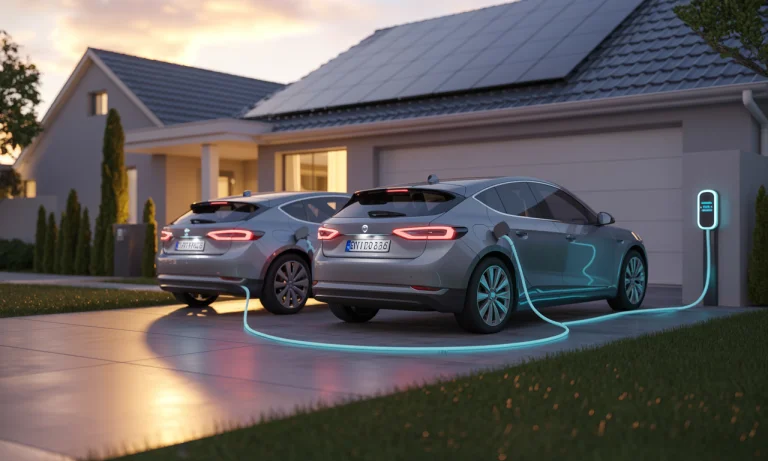As more drivers turn to electric vehicles to cut both emissions and recurring fuel costs, a new relationship with the household electric bill unfolds. The promise of lower maintenance, cleaner energy, and impressive acceleration from brands like Tesla, Nissan, Chevrolet, Ford, and BMW draws attention—but so does curiosity about long-term expenses. In neighborhoods where Rivian pickups blend with Hyundai, Kia, Audi, and Volkswagen EVs, questions about monthly energy costs echo from front porches to online communities. What actually happens to your electricity bill after you drive off with your first electric car? Revealing the mechanics behind EV charging, the fluctuating cost of power, and smart savings strategies, we follow everyday drivers recalibrating their budgets—and expectations—across the U.S. Discover how energy habits, local rates, and even solar panels shape the true price of going electric, as technology continues to shift the economics of the open road.
Charging Electric Cars at Home and Their Effect on Electricity Bills
Imagine a family replacing their aging gasoline sedan with a new Ford Mustang Mach-E or a Hyundai Ioniq 6. The most noticeable routine change arrives overnight: instead of filling up at a gas station, they connect their car in the garage and let the electric meters spin while the city sleeps. Charging at home is often the most convenient, but how much will it really cost each month?
Most American households find their electric bill rising by $30 to $60 monthly after adding a typical Nissan or Volkswagen EV into daily life. That figure can swing dramatically depending on local power rates, vehicle battery capacity, and the family’s driving patterns. SUVs like those from Kia or Rivian require larger batteries for longer ranges, drawing more kilowatt-hours (kWh) per week compared to the more modest BMW or Chevrolet compact models.
To offer context, a Level 2 charger (240V) installed at home draws significantly more power than a standard wall socket but finishes the job overnight. For deeper comparisons and insights, see how charging methods stack up at this comprehensive EV charging guide.
| EV Model | Battery Capacity (kWh) | Avg. Monthly Charging Cost ($) | Typical Range (miles) |
|---|---|---|---|
| Tesla Model 3 | 60 | 40 | 272 |
| Chevrolet Bolt | 65 | 37 | 259 |
| Ford Mustang Mach-E | 98 | 55 | 310 |
| Kia EV6 | 77 | 45 | 303 |
| Rivian R1T | 135 | 70 | 314 |
By tailoring charge times and tapping into off-peak rates, cost-savvy EV owners keep their bills reasonable, sometimes offsetting much of the additional charge. To go further, discover the latest range capabilities of EVs on the market.
Understanding Electric Car Charging Rates and Timing
Every electric vehicle—from the agile BMW i4 to the robust Audi Q4 e-tron—draws attention to the role of time-of-use plans, which reward drivers who charge overnight or midday with lower rates. Utilities often offer EV-specific plans, encouraging massive savings by plugging in after peak hours. Consider the case of a tech enthusiast charging his Tesla Model Y at midnight in Austin, Texas, paying just 8 cents per kWh compared to double or triple that at 5 pm.
This savvy timing can mean the difference between a $50 and a $75 monthly increase. In places with deregulated energy markets, like Texas and California, shopping for the right energy provider further fine-tunes these numbers. Compare local electricity plans and find your best strategy using this analysis of electric versus gas costs.
The True Cost and Savings: Electric Cars Versus Gasoline Vehicles
For generations, Americans calculated commuting costs at the gas pump—only now, fuel expenses are metered differently. Take the story of the Johnsons, who traded their gasoline SUV for a plug-in Kia EV6. With gas prices swinging between $2.50 and $4.00 per gallon over the past decade, the switch promised savings, but the line item on their utility statement began to climb.
On average, a gasoline-powered car that logs 1,000 miles monthly at 25 mpg and $3 per gallon costs approximately $120 per month in fuel. The same mileage for an EV—at a rate of $0.12 per kWh and a 90% charging efficiency—lands closer to $36 to $50 per month for popular models from Nissan, Chevrolet, or Hyundai. However, costs fluctuate for heavy commuters, luxury brands, or those locked into higher electricity rates.
| Fuel Type | Miles Driven Per Month | Monthly Energy/Fuel Cost ($) | Annual Maintenance Estimate ($) |
|---|---|---|---|
| Gasoline Car | 1,000 | 120 | 800 |
| Electric (e.g., Tesla, Nissan, Kia) | 1,000 | 45 | 350 |
While the electric bill rises, savings on gasoline and routine maintenance—oil changes, spark plugs—outweigh the increase for most, as explained in this deep dive on the true cost of EV ownership. For a broader look at maintenance over the years, see electric car maintenance breakdowns.
Smart Strategies for Minimizing Electric Vehicle Charging Costs
Not every driver wants to watch the meter spin. Some invest in rooftop solar panels, sending power through the wires to both home and Hyundai, offsetting a large share of the bill. For those living in multi-unit buildings, coordinating with landlords or property managers is key—sometimes charging at public stations owned by local utilities or the city makes more sense, especially if incentives or rebates are in play.
More advanced drivers schedule charging through connected apps on Kia, BMW, or Tesla vehicles, syncing with the lowest electricity rates. Others use power consumption trackers or set reminders to unplug before peak time starts. Navigating these options is part of the modern EV experience. Interested buyers can compare upcoming models and plan ownership with guidance found at the future of electric cars or explore incentives at this incentives overview.
Real-World Charging: Home Versus Public Stations
Out in the city, charging becomes part of the landscape. Public charging stations offer speed and convenience, especially for those without driveways or dedicated parking. However, with session fees, per-kWh pricing, and rapid chargers costing more, relying solely on public chargers can double or even triple monthly energy costs compared to home charging—a reality that commuters in places like Los Angeles or New York City know all too well.
Contrasts emerge between drivers. Busy professionals using fast charging every week in a BMW or Volkswagen might spend upwards of $80 to $100 per month solely on EV charging, erasing much of the savings found at home. Families clustered around Level 2 chargers in the suburbs pay far less, balancing cost, control, and convenience. Owners of luxury Audi or Rivian vehicles—often built for adventure and long trips—may rely more on these stations but can optimize by joining membership programs or seeking out network discounts.
For those pondering the best fit, comprehensive tips and user experiences can be found in resources like test-driving electric cars and family-focused guides at the best electric cars for families.
Key Factors Affecting Your Electricity Bill After Going Electric
Every journey starts with questions. A young family in Houston, eyeing a Volkswagen ID.4, wonders about the fine print: What time of day should we charge? Is the battery capacity worth the higher upfront cost? Will we save more if we go solar in a few years? Their experience echoes across online forums and dealerships, where the most pressing questions come not from technology, but from the numbers at the end of each month.
Choices about when and where to charge, battery capacity and car model, local electricity rates, home solar adoption, and incentive programs are all pieces of a complex puzzle. Mastering that balance brings the most value—not just for the wallet, but for a new era of clean, confident driving. To help new buyers navigate these crossroads, expert tips are available in this guide to choosing your first EV and the latest in battery advancements at battery innovation resources.
FAQs About Electric Cars and Electricity Bills
How much should I expect my electric bill to increase when charging an EV at home?
Most households see an increase of $30-$60 per month, but the exact cost depends on how much you drive, electricity rates in your area, and your specific EV’s battery size.
Do electric vehicles like Tesla and Rivian really save money compared to gas-powered cars?
While your electric bill increases, EVs eliminate gasoline costs and have fewer moving parts, leading to lower overall maintenance and often considerable savings over time.
Is it cheaper to charge an electric vehicle at home or at public stations?
Home charging is usually much less expensive, especially if you use off-peak electricity rates. Public fast chargers offer convenience but generally come with higher fees.
Can installing solar panels reduce the cost of charging my electric vehicle?
Absolutely. Solar panels can offset much or all of your EV charging costs, especially if your system generates more energy than your household uses. State and federal incentives may help with upfront installation expenses.
Are there ways to reduce my EV charging bill without investing in solar?
Yes: charge during off-peak hours, enroll in utility company incentive programs, explore time-of-use rate plans, and make use of any rebates or special EV rates your provider may offer. For more long-term strategies, check out these cost-saving car tips.
Did you like it? 4.7/5 (22)







